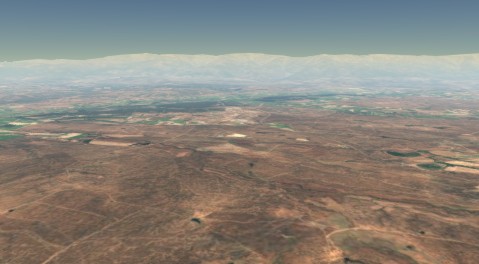
With a wingspan measuring up to 3 metres and a weight of up to 14 kg (typically 7-12 kg), the Cinereous Vulture is one of the largest birds. So, flying and travelling vast distances should require a lot of energy, but this species has its own ‘tricks’. Cinereous Vultures, similar to other large soaring species, utilize their surrounding landscape and weather conditions to take flight, gain uplift and maintain momentum with minimum effort. Thanks to GPS technology, we can watch and analyze precisely how they do so.
How do Cinereous Vultures move?
Cinereous Vultures and other vultures use spirals of hot air, known as thermals, to get airborne and soar high and far with minimum effort. Soaring requires specific body positioning to exploit thermals efficiently without flapping, which can be energy draining.
Tagging vultures with GPS tags enables us to develop GPX tracks that showcase how they move. In the track below, you can see the movements of Cinereous Vulture Rias during a short period of time. On 22 May from 12:20 -15:00, Rias traversed an 84 km trajectory. The bird was sitting for the first 30 minutes, then started flying, made a short stop and finally landed at a watering hole where he also stayed longer. The track shows how the vulture uses the landscape, using thermals to circle high and gain altitude, and then moving straight as it travels between thermals, repeating this sequence to travel long distances in a very energetically efficient way.

https://ayvri.com/embed/ogkl8e715n/ckajkfjc800013968kvj2mk0y#
Cinereous Vulture Rias
The Cinereous Vulture Rias was found weakened in December 2019 and weighed only 4kg in Ferreira do Alentejo in southern Portugal. To save the vulture, RIAS – Centro de Recuperação e Investigação de Animais Selvagens, Olhão in the Algarve rehabilitated the bird for almost two months! The team at the Centre managed to successfully nurse it back to health, reaching a weight of 7kg and was able to fly perfectly. Ahead of its release, the vulture was ringed and tagged with a GPS transmitter provided by us here at the Vulture Conservation Foundation (VCF) and funded by the MAVA Foundation to monitor its movements. On 6 February, the vulture was released at Herdade da Contenda, which is a Cinereous Vulture breeding colony in eastern Alentejo.
Following Cinereous Vultures in Portugal
In 2018, we provided the GPS tag for the first Cinereous Vulture to be tracked using a GPS transmitter in Portugal and we continued to tag more birds ever since. This information provided by tracking these birds is vital to reveal any threats the birds may face as the species continues to make a comeback across Portugal. The insight from this data will be useful for conservationists to enable them to carry out actions to reduce the risk the birds face and help support the restoration of vulture populations throughout their former range. You can follow these birds online by visiting the maps that are generated from the data collected from the GPS transmitters.
Read more about the energy efficient flight of vultures in these publications:
How Cheap Is Soaring Flight in Raptors? A Preliminary Investigation in Freely-Flying Vultures
Vultures respond to challenges of near-ground thermal soaring by varying bank angle
Adult vultures outperform juveniles in challenging thermal soaring conditions
You can monitor the movements of Cinereous Vultures equipped with GPS tags by visiting our online public maps.





